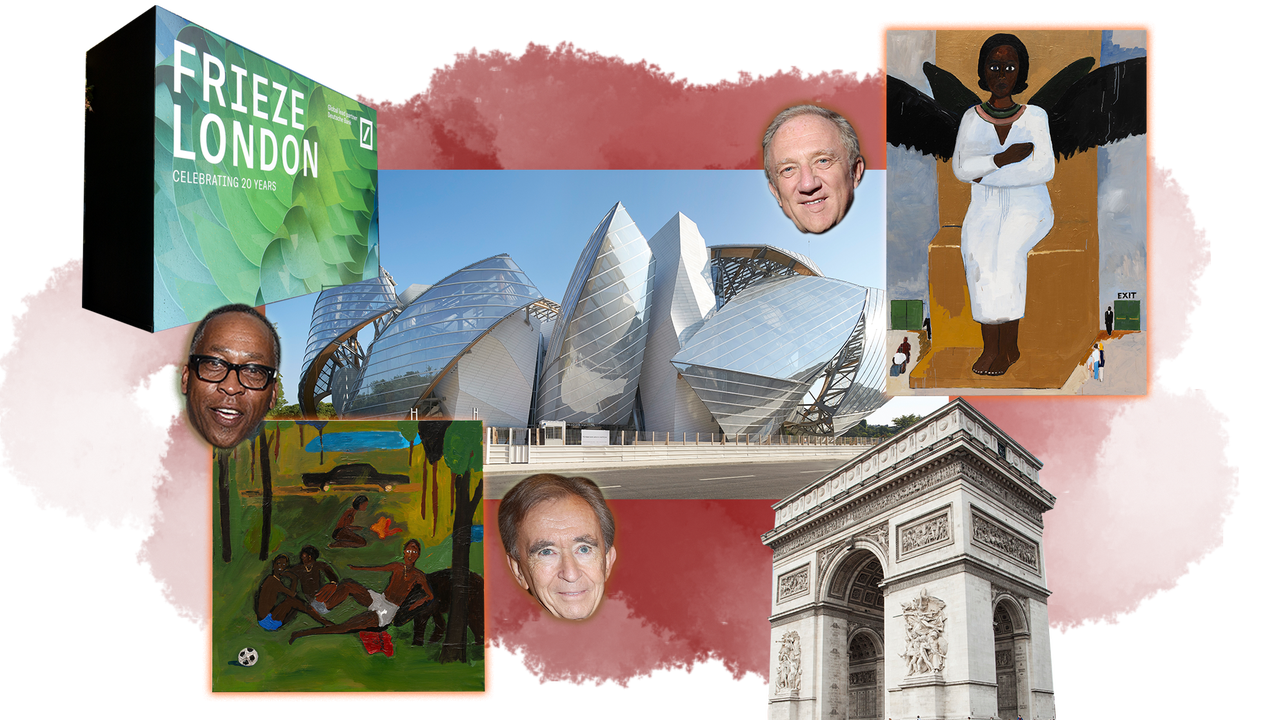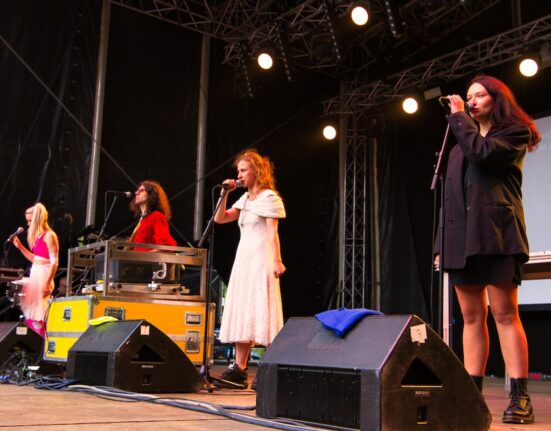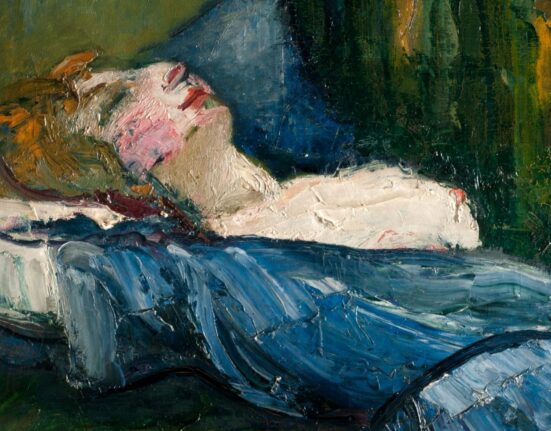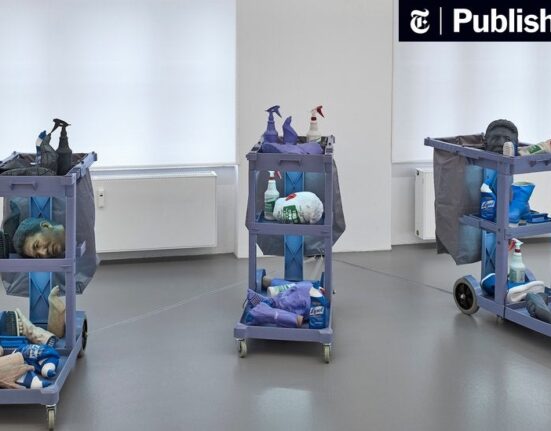Last Saturday in Paris, the global art enterprise Hauser & Wirth opened its 17th outpost, an expansive four-story space just off Avenue Matignon, in the 8th arrondissement. Until a few years ago, the move for a mega-gallery opening in the City of Light would be to open in Le Marais, the traditional gallery district in town. In 2019, David Zwirner, citing a need to transact in the EU post-Brexit, opened in that area, with a show of new work by Raymond Pettibon. The other mega-gallery, Gagosian, takes a different approach in Paris, supplementing its traditional gallery with a tiny space directly next to the Place Vendome and a gigantic hanger of space in Le Bourget, the city’s private jet hub, sitting there at the ready for those who hop off the jet stream itching to buy some art.
Hauser & Wirth decided to take over the 1877 hôtel particulier in the warren of high fashion boutiques that spill out on and around Avenue Matignon. In order to get to the gallery, one must window shop past the global flagships of Balenciaga, Celine, Gucci, Saint Laurent, and Bottega Veneta. With the crowd spilling out into the street, the storefront seemed from afar like another one of those boutiques, thronged with those willing to drop five figures on a coat. Instead, the crowd funneled into “From Sugar to Shit,” a show of new works by Henry Taylor, the artist whose retrospective opened at the Whitney Museum in New York earlier this month to rapturous crowds. The major paintings were on sale in the upper six figures, and they could have been sold several times over to the long list of collectors and institutions begging for the chance to buy.
“Hey, how’s it going man, was just talking about you!” went a typical greeting from Taylor to a visitor as they walked in, surprised to be greeted by the artist. Inside the space, billionaire collectors mingled with artists such as Alvaro Barrington, who is so prolific he’s represented by six galleries on three continents and has had 12 solo shows in six cities in two years. The party continued at a cocktail dînatoire at Les Bains Douche, the once debauched home to many a night when revelers took a dip in the pool for a nightcap. It’s been cleaned up enough that it could play host to a number of Taylor’s collectors, including the artist Rashid Johnson, who lent a work to the Whitney show and has portraits of him and his wife, the artist Sheree Hovsepian, hanging at their Gramercy Park home. Another collector, who also lent to the Whitney show, said that the Hauser show was actually better than that retrospective: all work made here in Paris, on deadline, in reaction to the city, immediate, visceral.
There was caviar, a lot of caviar, as well as tartare and duck and risotto, and eventually gallery founder Iwan Wirth bopped into the smoking section, where King Henry was holding court with Ewan Venters, the gallery’s global CEO who is making a big bet on opening up hotels and restaurants as part of their hospitality venture Artfarm. Revelers were making their way down to the dance floor, which still has a pool, albeit one more suited to admiring than wading. One question remained: What lucky collectors beat out the other billionaires and museums to score a work from Taylor’s show? The answer came later from a source. One of the buyers was, in some sense, the gallery’s neighbor: the owner of Balenciaga, Celine, Gucci, Saint Laurent, and Bottega Veneta, a billionaire named Monsieur Francois Pinault.
London and Paris hosted their annual art fair weeks this month, and despite the general sense of economic disarray and geopolitical turmoil facing much of Europe and the world, make no mistake: these two weeks were a battalion-force display of the impact of the soft power of the continent’s culture industries. Across the two eminent metropolises, political influence and capitalistic might combined to make art the main offer, for at least a few days, as Frieze London went down the second week of the month and Paris+ par Art Basel took over the City of Light the following week. Sure, these are art fairs, and each expo acts as an appendage of one master of the universe or another. Frieze is part of Ari Emanuel’s Endeavor, and Art Basel is part of James Murdoch’s private equity juggernaut Lupa Systems. But the offerings of each days-long art-viewing spree went well beyond the works being sold in booths under tents. For a fortnight, the cities, a Eurostar ride apart, provided a deliciously rich offering of high-wattage museum shows, gallery openings, private collection views, studio visits, four-hour-long dinners, and, of course, more than a couple parties.
“We are in a golden age for British arts and culture and the government will do all we can to continue to maximize the potential of our creative industries, which boasts talent the length and breadth of the UK,” the country’s culture secretary Lucy Frazer said in a statement.
To prove as much, on the night before the opening of Frieze London, Prime Minister Rishi Sunak invited a number of London’s arts personalities and power brokers to 10 Downing Street for cocktails and canapés, and to see what art from the government’s collection he had up on the walls. It was mostly old stuff, rather than contemporary, attendees reported. Not everyone was psyched to receive an invite. According to reports, the artist Ryan Gander, who had a show up at London’s Lisson Gallery, snubbed the Conservative PM, saying “There is only one way out of broken Britain and that is to not entertain these idiots whatsoever.” Zoé Whitley, director of the Chisenhale Gallery in town, declined to attend the bash, and Sarah McCrory, the director of the contemporary gallery at Goldsmiths, cited Number 10’s pesky habit of cutting funding for the arts as a reason for skipping out. Among other reasons.
“Also, did everyone miss the PM’s transphobic speech at the Tory party conference?” McCrory said in a statement first reported by The Art Newspaper. “There’s no way I’d eat his hors d’oeuvres.”
By all accounts, the party was packed anyway, and the next morning, Frieze opened two fairs in Regent’s Park, with some big-sticker works selling despite the headwinds going against the art market at the moment. Hauser & Wirth sold a classic Louise Bourgeois for $3 million, and Spruth Magers sold a fresh-from-the-studio George Condo for an astounding $2.6 million.
Outside of the fairs, it’s the institutions that need the funds to go forward, and they turn to those with means: the billionaires, the government, the wielders of soft power. The Serpentine board has long been chaired by Michael Bloomberg, whose Bloomberg Philanthropies has supported the Hyde Park institution for years. The Nicole Eisenman show at the Whitechapel Gallery was supported by her galleries—Anton Kern, Vielmetter, and Hauser & Wirth—but funds still ran out after a certain threshold. Under a reproduction of Eisenman’s masterful “The Abolitionists in the Park,” which has been in the collection of the Metropolitan Museum of Art in New York since just after it was first shown in 2021, the wall text explained that, “When the costs of transporting the painting to Europe escalated, the curators decided to display this reproduction, fully acknowledging the compromise this entails.”
“You can’t support these museum shows without serious support from the galleries, and the lenders,” said Alison Jacques, the longtime London gallerist who recently moved to Mayfair with a new big space on Cork Street. “So now, when someone gives a painting on loan, you have to say, ‘Can I get $10,000 too?’”
Another major show was “Sarah Lucas: Happy Gas” at the Tate Britain—a major coronation moment for one of the more critically acclaimed but commercially undersung YBAs. It too needed help on the funding side. The lead sponsor visible upon entry, even ahead of Lucas’s galleries, was Burberry, the British luxury brand that does over $3.7 billion in revenue per year. Not that anyone minded, exactly. Burberry and Sadie Coles HQ hosted a dinner for Lucas at St. John, the Vatican of nose-to-tail cooking helmed by the pope of offal himself, Fergus Henderson. Matthew Barney sat across from actors Samantha Morton and Joel Edgerton, and Rita Ora and Barry Keoghan scooped marrow out of dinosaurian bones and onto butter-griddled toasts. My table mate was Bruno Brunett, the founder of the legendary Berlin tastemaking gallery Contemporary Fine Arts, who told story after story about Lucas’s Berlin shows back in the day, about London in the 90s, about dining at St. John with artists too scared to say hello to Lucien Freud the table over. When Brunett came back to his seat at one point, he mentioned he just met the most fantastic dinner guest. An artist? A new art-collecting client?
“I just met Burberry designer Daniel Lee in the men’s,” he said, ecstatic.
Upon arriving in Paris via the Eurostar, it became immediately clear that the display of soft power would not just match that in London, it would surpass it, by a notable amount. In the days before the fair opened, the French government allowed a select few art world insiders to come to the Musee d’Orsay on a Monday, when it is usually shut, well past usual business hours, to see a show of works by the perennial market darling Peter Doig installed in a breathtaking gallery immediately next to the state-held treasures, its Manets and Monets and Renoirs and van Goghs. Doig has no gallery representation at the moment, though several gallery honchos were there, David Zwirner among them. I spotted shipping heir Theo Niarchos staring at one painting, and French actor Clemence Poesy looking at another, and the Prada designer Raf Simons looking at another, and Henry Taylor and Alvaro Barrington looking at others yet. Sponsors to the show include the consultants Mazars, and the fashion conglomerate LVMH, which had more than $80 billion in revenue in 2022. It’s founder, Bernard Arnault, is the world’s second richest man.
Across town, the mega-collector Francois Pinault, whose holding company Artemis recently purchased a majority stake in CAA for reportedly around $7 billion and has owned the auction house Christie’s since the 90s, has his own private museum in town, the Bourse de Commerce, and it’s hosting a major exhibition of work by American artist Mike Kelley, one that would be daunting for any American museum to stage.
It’s the second year of Paris+ Art Basel, though it still won’t take over its permanent home in the Grand Palais until 2024, after the Olympics. And yet the whole operation already feels like an institution, and FIAC—the long-running Paris art fair that Basel displaced when it negotiated with the Reunion des musees nationaux Grand Palais for a seven-year lease on the mid-October slot—was at best an afterthought. It certainly was not mentioned during this year’s Art Basel press conference, which was hosted not at the fair, but at Lafayette Anticipations, the long-in-the-works permanent gallery space owned by the department store empire Galeries Lafayette, still run by the 96-year-old matriarch Ginette Moulin. Upstairs at the space, a show of work by Issy Wood took up multiple floors. An Akeem Smith show was in another exhibition space on the other side of the facility. While acknowledging the troubling news coming out of various parts of the world, Art Basel CEO Noah Horowitz stood up at the fair’s press conference and said that he was confident that the spirit of this city would allow for the Basel fair in Paris to be on par with its other fairs in Miami Beach, Hong Kong, and Basel Switzerland.







